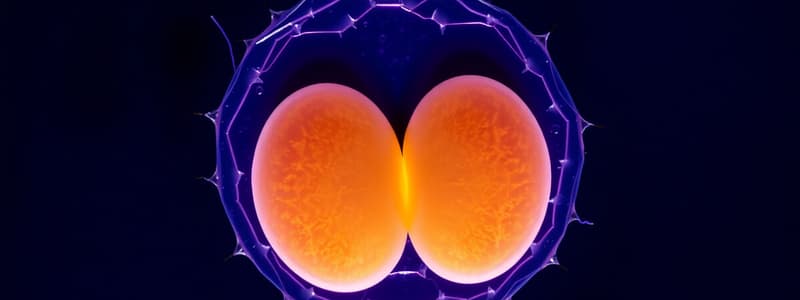Podcast
Questions and Answers
What happens during Interphase?
What happens during Interphase?
- DNA is duplicated (correct)
- Cell divides
- Chromosomes condense
- Cell grows (correct)
What occurs during Prophase 1?
What occurs during Prophase 1?
Nuclear envelope begins to dissolve, DNA starts to condense, genetic recombination can occur.
What happens during Metaphase 1?
What happens during Metaphase 1?
Homologous chromosome pairs line up in the center and spindle fibers attach to the centromere.
What is the outcome of Anaphase 1?
What is the outcome of Anaphase 1?
What occurs in Telophase 1?
What occurs in Telophase 1?
What is the function of Cytokinesis 1?
What is the function of Cytokinesis 1?
What happens during Prophase 2?
What happens during Prophase 2?
What occurs in Metaphase 2?
What occurs in Metaphase 2?
What is the outcome of Anaphase 2?
What is the outcome of Anaphase 2?
What occurs during Telophase 2?
What occurs during Telophase 2?
What is the result of Cytokinesis 2?
What is the result of Cytokinesis 2?
Flashcards are hidden until you start studying
Study Notes
Meiosis Overview
- Meiosis consists of two sequential divisions: Meiosis I and Meiosis II, resulting in four haploid cells from one diploid cell.
- Key stages of meiosis include Interphase, Prophase, Metaphase, Anaphase, Telophase, and Cytokinesis for both divisions.
Interphase
- G1 phase: Cell growth occurs, preparing for division.
- S phase: DNA duplication takes place, ensuring each new cell has a complete set of chromosomes.
- G2 phase: Further cell growth and preparation for meiosis.
Meiosis I
Prophase 1
- Nuclear envelope begins to break down, allowing chromosomes to interact.
- Chromatin condenses into visible chromosomes.
- Genetic recombination occurs through crossing over between homologous chromosomes, increasing genetic diversity.
Metaphase 1
- Homologous chromosome pairs align along the metaphase plate in the cell center.
- Spindle fibers attach to the centromeres of the homologous chromosomes, preparing for separation.
Anaphase 1
- Homologous chromosomes are pulled apart toward opposite poles of the cell.
- This separation promotes genetic variation, resulting in gametes with unique combinations of alleles.
Telophase 1
- Nuclear envelope begins to reform around each set of separated chromosomes.
- At the end of this stage, one diploid cell undergoes division into two haploid cells.
Cytokinesis 1
- Cytoplasmic division occurs, formally separating the two newly formed haploid cells.
- Transition from diploid (2n) to haploid (n) is completed.
Meiosis II
Prophase 2
- Nuclear envelope dissolves again in each haploid cell.
- Chromosomes condense, preparing for the next division without further DNA replication.
Metaphase 2
- Chromosomes align along the metaphase plate in the center of each cell.
- Spindle fibers attach directly to the centromeres of each chromosome.
Anaphase 2
- Sister chromatids are pulled apart and move to opposite poles, forming two daughter chromosomes per chromatid.
- This phase resembles mitosis at a cellular level.
Telophase 2
- The two haploid cells split again, resulting in a total of four haploid cells.
- Chromosomes unwind into chromatin, and nuclear envelope re-forms around each set of chromosomes.
Cytokinesis 2
- Final separation of the two haploid cells occurs, resulting in four distinct gametes.
- Each gamete contains a haploid number of chromosomes, ready for fertilization.
Studying That Suits You
Use AI to generate personalized quizzes and flashcards to suit your learning preferences.




